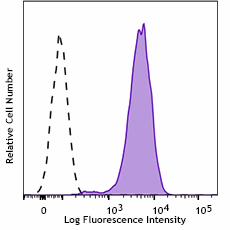- Clone
- QA20A17 (See other available formats)
- Regulatory Status
- RUO
- Other Names
- T1a, gp38, stromal cell marker
- Isotype
- Rat IgG1, κ
- Ave. Rating
- Submit a Review
- Product Citations
- publications

-

TE-71 cells (mouse thymic medullary epithelial cell line) were stained with purified anti-mouse Podoplanin recombinant (clone QA20A17) (filled histogram) or purified rat IgG1,κ isotype control (open histogram), followed by goat anti-mouse IgG PE.
| Cat # | Size | Price | Quantity Check Availability | Save | ||
|---|---|---|---|---|---|---|
| 100902 | 100 µg | 132€ | ||||
The mucin-type glycoprotein podoplanin is thought to be involved in the development of the lymphatic vascular system. Podoplanin is named after its expression in the kidney glomerular epithelial cells (podocytes). It has a potential role in tumor progression.
Product DetailsProduct Details
- Verified Reactivity
- Mouse
- Antibody Type
- Recombinant
- Host Species
- Rat
- Formulation
- Phosphate-buffered solution, pH 7.2, containing 0.09% sodium azide
- Preparation
- The antibody was purified by affinity chromatography.
- Concentration
- 0.5 mg/mL
- Storage & Handling
- The antibody solution should be stored undiluted between 2°C and 8°C.
- Application
-
FC - Quality tested
- Recommended Usage
-
Each lot of this antibody is quality control tested by immunofluorescent staining with flow cytometric analysis. For flow cytometric staining, the suggested use of this reagent is ≤ 0.25 µg per million cells in 100 µL volume. It is recommended that the reagent be titrated for optimal performance for each application.
- Application Notes
-
Clone QA20A17 can completely block the binding of clone 8.1.1 on target cells.
- RRID
-
AB_2894640 (BioLegend Cat. No. 100902)
Antigen Details
- Structure
- 43 Kd glycosylated type-1 transmembrane protein. Mucin-type protein.
- Distribution
-
Expressed on epithelial and mesothelial cells.
- Cell Type
- Epithelial cells
- Biology Area
- Cell Biology, Immunology, Neuroscience, Neuroscience Cell Markers
- Antigen References
-
- Farr A, et al. 1992. J Histochem Cytochem. 40:651.
- Schacht V, et al. 2005. Am J Pathol. 166:913.
- Gene ID
- 14726 View all products for this Gene ID
- UniProt
- View information about Podoplanin on UniProt.org
Related Pages & Pathways
Pages
Related FAQs
Other Formats
View All Podoplanin Reagents Request Custom Conjugation| Description | Clone | Applications |
|---|---|---|
| Purified anti-mouse Podoplanin Recombinant Antibody | QA20A17 | FC |
Compare Data Across All Formats
This data display is provided for general comparisons between formats.
Your actual data may vary due to variations in samples, target cells, instruments and their settings, staining conditions, and other factors.
If you need assistance with selecting the best format contact our expert technical support team.
-
Purified anti-mouse Podoplanin Recombinant Antibody

TE-71 cells (mouse thymic medullary epithelial cell line) we...
 Login / Register
Login / Register 







Follow Us